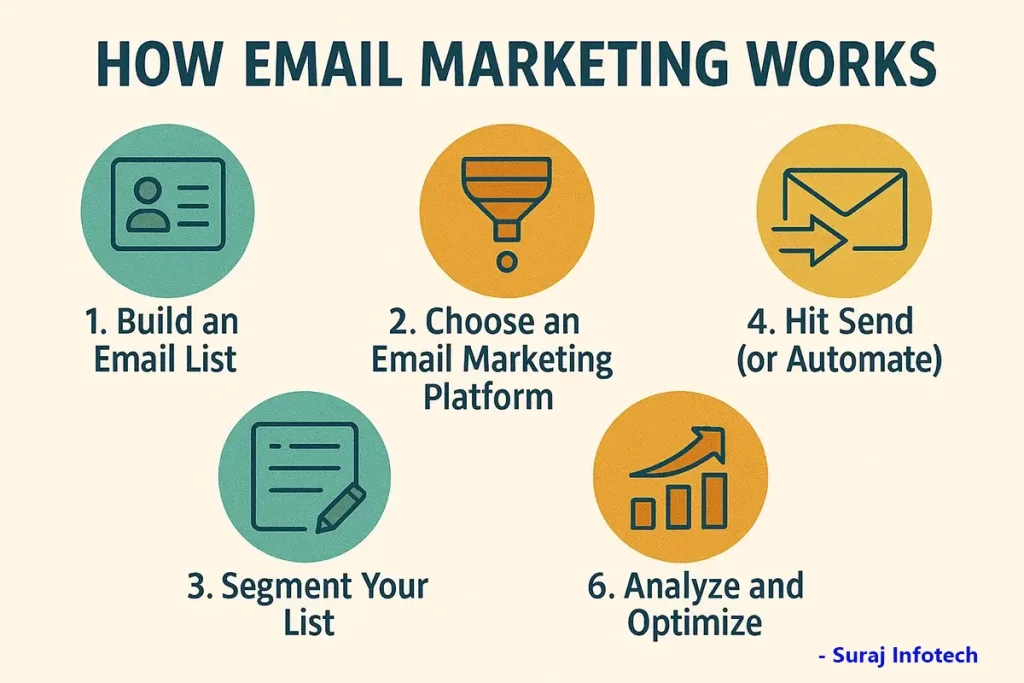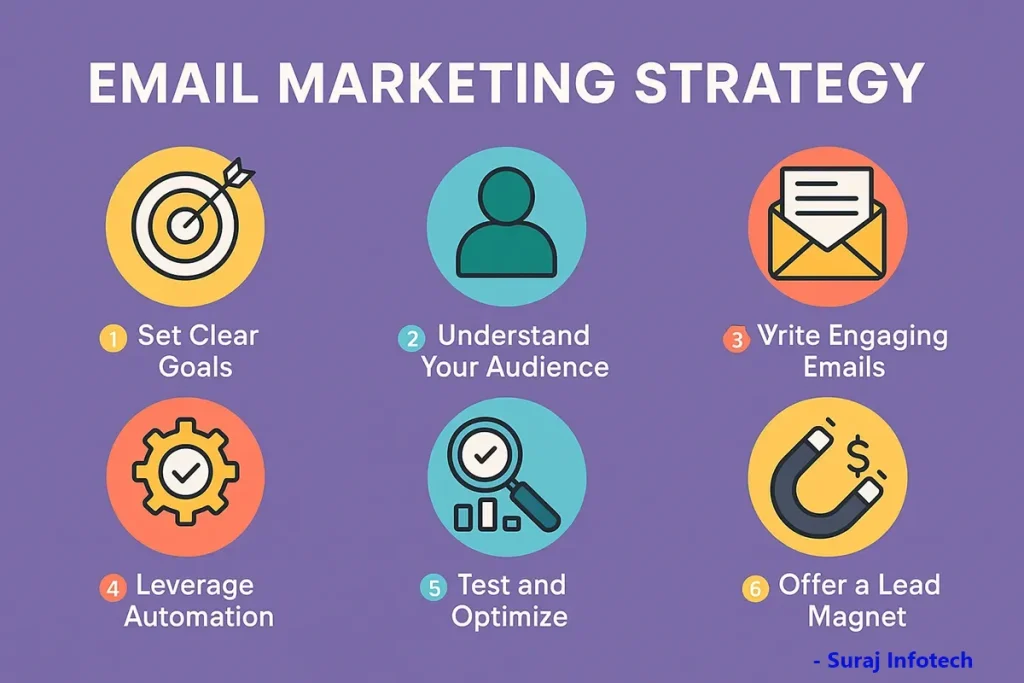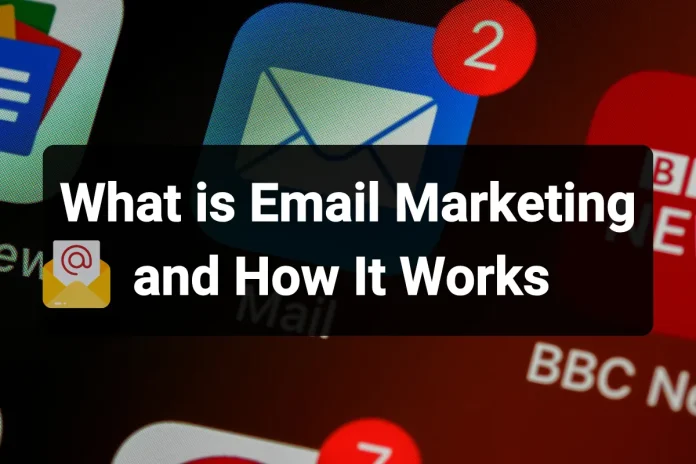The Power of Email Marketing
Imagine reaching your customers directly in their inbox with a message tailored just for them. That’s the magic of email marketing. But what is email marketing?
It’s a strategy where businesses send targeted emails to engage, inform, or convert their audience.
In 2025, email marketing remains one of the most effective ways to build relationships and drive sales.
This guide will walk you through how email marketing works, the best platforms, types of emails, and a beginner-friendly strategy to get started. Let’s unlock the potential of your inbox!
What is Email Marketing?
Email marketing is the practice of using email to connect with your audience, whether to promote products, share updates, or nurture relationships.
Unlike social media posts that might get lost in algorithms, email marketing delivers your message straight to your subscribers’ inboxes, offering a personal and controlled way to communicate.
Why does email marketing matter? It boasts an impressive ROI—$42 for every $1 spent, according to a 2023 Litmus report.
It’s affordable, scalable, and works for everyone, from solopreneurs to global brands. Here’s why it’s a game-changer:
- Direct Access: Reach customers where they check daily—their inbox.
- Personal Touch: Customize emails to match individual preferences.
- Trackable Results: Measure opens, clicks, and conversions easily.
For example, a small bakery might use email marketing to send a “Buy One, Get One” coupon to loyal customers, driving foot traffic without breaking the bank.
Why Email Marketing Still Works Great in 2025
You might think email is outdated, but it’s actually more relevant than ever:
- Over 4.6 billion email users globally
- $42 average ROI for every $1 spent on email marketing
- Direct access to your audience (no algorithms involved)
- Customizable, personal, and scalable
- Email tools are smarter now – they can handle a lot for you automatically.
Email marketing helps you build trust, nurture leads, and drive conversions without relying solely on social media or paid ads.
How Email Marketing Works

Email marketing is a process that moves your audience from curious to committed. Here’s a breakdown:
Step 1: Build an Email List
Curious about how email marketing works? It’s a blend of strategy, tools, and creativity.
You need permission to email someone. Start by collecting emails through:
- Sign-up forms
- Free lead magnets (like ebooks or discounts)
- Webinar or event registrations
Step 2: Choose an Email Marketing Platform
Popular tools include:
- Mailchimp
- ConvertKit
- Sendinblue
- MailerLite
- ActiveCampaign
These platforms help you send mass emails, automate sequences, and track performance.
READ ALSO:
Step 3: Segment Your List
Sort your email subscribers by their interests, shopping habits, or past clicks to send messages that feel personal.
Step 4: Write & Design Your Email
Make your emails:
- Clear and concise
- Visually appealing
- Personalized (use names, purchase data, etc.)
Step 5: Hit Send (or Automate)
You can schedule your emails or set up automated workflows like welcome series, abandoned cart emails, or birthday greetings.
Step 6: Analyze and Optimize
Track open rates, click-through rates (CTR), and conversions to improve future campaigns.
Types of Emails for Email Marketing
Here are the most common types of emails marketers use:
- Welcome Emails – First impressions matter. Greet new subscribers warmly.
- Newsletter Emails – Share updates, tips, or curated content regularly.
- Promotional Emails – Announce sales, offers, or new products.
- Transactional Emails – Confirmations, receipts, or account notifications.
- Abandoned Cart Emails – Send friendly reminders when someone forgets to buy something they added to their cart.
- Re-engagement Emails – Win back inactive subscribers.
- Survey/Feedback Emails – Ask for opinions and improve your service.
- Event Invitations – Invite your subscribers to online or offline events.
- Product Updates or Launches – Keep users informed about what’s new.
Top Email Marketing Platforms
Choosing the right platform is crucial. Here are some of the top email marketing tools you can use in 2025:
Mailchimp
Best for beginners and small businesses with free tier access.
ConvertKit
Great for bloggers, creators, and digital product sellers.
ActiveCampaign
Advanced automation features for growing businesses.
Brevo (formerly Sendinblue)
All-in-one marketing tool with great value for money.
MailerLite
Clean interface, good automation, and perfect for startups.
GetResponse
Offers webinar features, automation, landing pages, and more.
Klaviyo
Ideal for e-commerce stores with deep integrations and segmentation tools.
READ ALSO:
- Content Strategy Example: How to Build a Winning Plan in 2025
- How to set up Google Ads account: Step-by-Step PPC Guide for Beginners 2025
Email Marketing Strategy for Beginners

Building an email marketing strategy for beginners is easier than it sounds. With email marketing at the core, follow these steps to create campaigns that convert in 2025:
Step 1: Set Clear Goals
Decide what you want from email marketing. Goals might include boosting sales, increasing website visits, or growing your subscriber list. Be specific, like “add 300 subscribers in 60 days.”
Step 2: Understand Your Audience
Segment your list by interests, demographics, or actions. For example, a pet store might segment by “dog owners” and “cat owners” to send relevant offers.
People won’t just give you, their email. Offer something valuable in return:
- Discount code
- Free download
- Webinar registration
Step 3: Write Engaging Emails
Craft emails that feel personal. Use friendly language, compelling subject lines (e.g., “Your Exclusive Offer Awaits!”), and CTAs like “Shop Now.”
Don’t overdesign. Keep your message short, clear, and always include a strong Call to Action (CTA) so people know what to do next.
Step 4: Leverage Automation
Automate sequences like welcome emails or cart reminders to save time. Platforms like Brevo make automation simple for email marketing beginners.
Create a schedule: weekly, bi-weekly, or monthly. Consistency builds trust.
Step 5: Test and Optimize
Experiment with A/B tests on subject lines or send times. For example, test “20% Off Today” vs. “Don’t Miss This Deal” to find what works best.
Step6: Offer a Lead Magnet
Provide free guide, discount, Add signup forms to your website & social media.
Benefits of Email Marketing for Different Industries
Email marketing can be customized for various industries:
- E-commerce: Boost sales with promotions, cart recovery, and product recommendations.
- Bloggers/Creators: Share your latest content and grow a loyal audience.
- B2B Companies: Nurture leads through educational newsletters and whitepapers.
- Service Providers: Automate onboarding, updates, and appointment reminders.
- Nonprofits: Drive donations, event participation, and volunteer support.
- Coaches/Consultants: Share insights, updates, and attract new clients.
- SaaS Companies: Deliver onboarding sequences and feature updates.
Examples of High-Converting Email Campaigns
Want some inspiration? Here are winning ideas:
- Welcome Series: 3-part sequence introducing your brand and offer
- Flash Sale Alert: Limited-time discount to create urgency
- Weekly Round-Up: Curated list of articles, tools, or resources
- Testimonial Email: Build trust with reviews from real customers
- Birthday Email: Celebrate subscribers and include a personal discount
- Mini Course Email Series: Teach something valuable over a few days
- Exclusive Insider Access: Offer VIP sneak peeks or first dibs
Email Marketing Examples to Inspire You
Looking for email marketing examples? These real-world campaigns show how email marketing can shine:
- Chubbies’ Playful Welcome Email: This brand uses humor and vibrant visuals to welcome subscribers, offering a discount to spark interest.
- Airbnb’s Personalized Suggestions: Airbnb sends travel recommendations based on user searches, driving bookings with tailored content.
- Sephora’s Abandoned Cart Sequence: Sephora’s multi-email series reminds users of their cart with product highlights and a clear CTA.
These examples prove that creativity and relevance are key to successful email marketing.
Smart Ways to Grow Your Email List
Already using a lead magnet? Try these:
- Exit-intent popups to catch abandoning visitors
- Content upgrades (extra PDF/download tied to a blog post)
- Referral rewards to let users invite others
- Contests or giveaways that require email sign-up
- Use social proof: “Join 10,000+ subscribers getting weekly insights!”
- Quizzes that deliver results via email
- Embedded signup forms in blog posts with inline CTAs
Email Marketing vs Other Marketing Channels
| Channel | Pros | Cons |
| Email Marketing | High ROI, direct access, automation | List building takes time |
| Social Media | Good for engagement, brand awareness | Algorithms limit reach |
| SEO | Long-term traffic | Time-intensive, slow results |
| Paid Ads | Fast visibility | Costly, short-term |
| SMS Marketing | High open rates | Limited content, requires opt-in |
Combining email with other channels is the best approach.
Example: A small e-commerce brand might rely on social media to attract new followers and build brand awareness, but use email marketing to convert those followers into paying customers by sending personalized discount offers or abandoned cart reminders.
Similarly, a B2B company could use SEO to generate organic traffic, then capture leads through a free guide and nurture them with automated email sequences.
Email Marketing Compliance (GDPR, CAN-SPAM, etc.)
Following regulations is key to avoid penalties and maintain trust:
- Use clear consent forms (no pre-ticked boxes)
- Give easy unsubscribe options in every email
- Include your business address in the footer
- Don’t send spammy content or deceptive subject lines
- Honor unsubscribe requests quickly
Also, follow email sending limits set by your provider to maintain deliverability.
Bonus Tips to Boost Engagement
- Use emojis in subject lines (sparingly!) to grab attention
- Include user names with dynamic tags like {{FirstName}}
- Resend to non-openers after 2–3 days with a tweaked subject
- Make emails scannable: use bullet points, short paragraphs
- Use storytelling to connect emotionally with your audience
- Add a P.S. line for one last CTA
- Include social sharing buttons to boost reach
How to Start Email Marketing in 2025
- Add a sign-up form to your website or blog to collect emails from interested visitors.
- Use Double Opt-In to confirm subscribers
- Segment Your List from day one
- Plan a Welcome Sequence with 3-5 emails
- Schedule Regular Content that offers value
- Clean Your List every 3-6 months
- Measure KPIs (Open Rate, CTR, Unsubscribes)
- Review Competitor Emails for inspiration
Common Email Marketing Mistakes to Avoid
- Buying email lists – Low engagement and potential legal issues
- Ignoring mobile optimization – Over 60% of emails are opened on phones
- Poor subject lines – Boring or spammy = low open rates
- Too many emails – You’ll get unsubscribed fast
- Lack of personalization – One-size-fits-all rarely works
- Skipping A/B tests – You miss valuable optimization data
FAQs: What Is Email Marketing for Beginners in 2025
Q1. What is email marketing?
What is email marketing? It’s when a business sends emails to people to share news, sell stuff, or build friendships. Imagine a pet store emailing you about new dog toys or a coupon.
Email is more than just selling – it’s a great way to stay in touch and build trust with your audience.
Email marketing is awesome because it’s personal and part of a smart email marketing strategy.
Q 2. How does email marketing work?
To get what is email marketing, picture this: you sign up for a store’s emails on their website.
They use a tool like Mailchimp to send you cool messages, like a sale alert or a fun tip.
The emails are made to interest you, so you might visit their shop or buy something. That’s how an email marketing strategy works!
Q 3. Why should I care about email marketing?
Email marketing is super helpful because it talks straight to people who like your stuff. One of the big email marketing benefits is keeping customers excited.
For example, a skateboard shop might email tricks and deals to get kids to visit. Knowing what is email marketing shows you how it brings people back to your business!
Q 4. What kinds of emails can I send?
Learning what is email marketing means knowing the fun types of emails:
Newsletters: Updates, like a weekly tip or story.
Sale Emails: Cool deals, like “Buy one, get one free!”
Hello Emails: A warm welcome for new subscribers.
Order Emails: Notes about what someone bought.
These are great email campaign tips to try!
Q 5. How do I start email marketing if I’m new?
Don’t worry, email marketing for beginners is easy! Here’s how to start:
Pick a tool like Mailchimp—it’s simple to use.
Add a sign-up box on your website for emails.
Send a fun “welcome” email to new fans.
Share stuff like tips or discounts every week.
That’s a basic email marketing strategy to begin!
Q 6. What makes an email really good?
A great email grabs attention and feels friendly. Some email campaign tips for what is email marketing include:
Use the person’s name, like “Hey, Alex!”
Write a catchy subject, like “Big Sale Today!”
Make it easy to read on phones.
Add a button, like “Check This Out!”
These tricks make people love your emails!
Q 7. How do I get more people to join my email list?
To grow your list for what is email marketing, try these ideas:
Put a sign-up form on your website’s homepage.
Give away something cool, like a free guide or coupon.
Share your sign-up link on social media.
For example, a game store might offer a free poster for signing up, boosting your email marketing strategy.
Q 8. Is email marketing different from social media?
Yep, they’re different! What is email marketing? It’s like a private letter to your fans, sent to their inbox.
Social media is like shouting to everyone on a busy street. Emails are great for special offers, while social media shares quick updates.
Using both makes your email marketing strategy even stronger for email marketing for beginners.
Q 9. How do I know if my emails are working?
To check if your email marketing strategy rocks, look at:
Opens: How many people read your email.
Clicks: How many clicked a link inside.
Actions: Did they buy something or sign up?
Tools like Mailchimp show these numbers, helping you use email campaign tips to improve.
Q 10. Do I need to hire someone for email marketing?
Nope, you can do it yourself! Email marketing for beginners is fun with tools like Mailchimp, which have easy templates.
Once you know what is email marketing, you can send simple emails like a pro.
If you have a big business or want fancy campaigns, a helper might be nice, but you can start small on your own!
Conclusion: Ready to Hit Send?
Think of email marketing as talking directly to your customers, helping them with useful tips, updates, or special offers.
Whether you’re launching a business, starting a blog, or expanding your brand, learning what is email marketing and how it works gives you a powerful tool to engage your audience.
So start building your list, craft valuable content, and create campaigns that your audience will actually want to read.
👉 Need help choosing an email marketing platform or setting up your first campaign?
